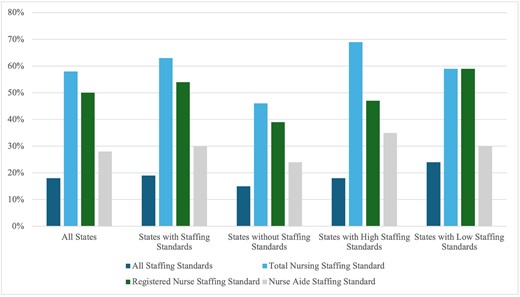-
PDF
- Split View
-
Views
-
Cite
Cite
Deepon Bhaumik, David C Grabowski, Implementation challenges of the new federal nursing home staffing rules will vary across states, Health Affairs Scholar, Volume 3, Issue 2, February 2025, qxaf009, https://doi.org/10.1093/haschl/qxaf009
Close - Share Icon Share
Introduction
In April 2024, the Centers for Medicare and Medicaid Services (CMS) released a final rule establishing minimum staffing standards for residents in Medicare and Medicaid certified nursing homes. The final rule states that all facilities must provide at least 3.48 total direct care hours per resident day (HPRD), which can be met by registered nurses (RNs), licensed practical nurses (LPNs), and nurse aides (NAs). The new rule also requires that nursing homes provide 0.55 RN HPRD and 2.45 NA HPRD. Most nursing homes do not currently meet the new federal standards.1-3
Predating the federal rule, 34 states had established their own overall staffing standards.4 Research studies have generally found the introduction of these state standards increased staffing and improved outcomes, but they also have led to unintended consequences such as lowering the share of licensed nurses and decreasing the number of dietary and housekeeping staff.5,6 The objective of this study is to examine whether states with minimum staffing standards are more likely to be in compliance with the new federal rule.
Methods
Our study used Payroll Based Journal staffing data from the second quarter of 2023 to the first quarter of 2024. Nursing homes are required to report the number of paid service hours of every staff member (both contract staff and those employed by the facility) for every day of work. Daily resident census information is obtained through the minimum data set. Staffing levels are measured as HPRD, which is calculated by dividing the total number of hours worked by facility staff, by the total number of residents. We compute a facility's staffing level by taking an average across our study period.
State staffing standards were determined using a recent report from the Medicaid and CHIP Payment Access Commission.4 We categorize states with standard standards as “high” and “low.” “High” staffing standards were defined as states in the top quartile of staffing standards, while “low” staffing standards were those in the bottom quartile. We assessed the share of facilities that report a staffing level, on average that would currently meet the final rule across states.
Results
Our sample included 13 734 facilities. We found that, on average, 18% of facilities in the US meet all three provisions of the final rule, 58% meet the total nursing staffing rule, 50% meet the RN staffing rule, and 28% meet the NA rule. (Figure 1) Among states with existing total nursing staffing standards, 19% of facilities in those states currently meet all three provisions of the final rule, 63% meet the total nursing staffing rule, 54% meet the RN staffing rule, and 30% meet the NA rule. Compared with states with high staffing standards, states with low staffing standards had 10% points and 5% points fewer facilities meeting the total nursing staffing rule and NA rule, respectively, yet had 6% points more facilities meeting all three provisions of the final rule and 12% points more facilities meeting the RN rule. In states without total nursing staffing standards, 15% of facilities currently meet all three provisions of the final rule, 46% meet the total nursing staffing rule, 39% meet the RN staffing rule, and 24% meet the NA rule.

Share of nursing homes meeting new federal staffing standards, second quarter of 2023 to the first quarter of 2024. Note: The “24/7” RN staffing standard of the new CMS rule is not included in the category “All Staffing Standards.” “High” staffing standards were defined as states in the top quartile of staffing standards, while “low” staffing standards were defined as states in the bottom quartile of staffing standards. Staffing data were included for the following job categories: RNs, RNs with administrative duties, RN Director of Nursing, LPNs, LPNs with administrative duties, certified NAs, NAs in training, and medication aides/technicians. Our study sample included facilities with complete staffing data for each of our calendar quarters. We excluded Washington, DC from our study. We also excluded hospital-based nursing facilities. Source: Authors’ calculations using payroll-based journal data.
Discussion
These findings suggest the implementation of the new federal staffing rule will vary across states and will interact with existing and future state requirements. Depending on the existing state staffing rules, nursing homes may have to increase their overall staffing or change the composition of their current staffing, or potentially do both, to meet the new federal rule. However, states with more stringent staffing rules generally are better positioned to meet the new federal rule. Nevertheless, additional staff will be needed in every state.
Where will nursing homes recruit these additional staff? Since the start of the pandemic, nursing homes have increasingly relied on agency and foreign-born workers to staff facilities.7,8 However, this type of increase in staff will require new strategies, likely including increased pay. This leads to a second question, how will nursing homes pay these additional staff? Nursing homes suggest low Medicaid payment makes it challenging to afford additional staff, while advocates contend many nursing homes do not direct enough dollars to paying workers. Staffing is a symptom of a broader set of problems with nursing home payment and financial accountability.3,9 Until the US invests in broader nursing home reform, it will be challenging to solve the staffing issue through a federal minimum standard alone.
Supplementary material
Supplementary material is available at Health Affairs Scholar online.
Funding
D.C.G. has received research support from the Warren Alpert Foundation.
Notes
Author notes
Conflicts of interest: Please see ICMJE form(s) for author conflicts of interest. These have been provided as supplementary materials.



